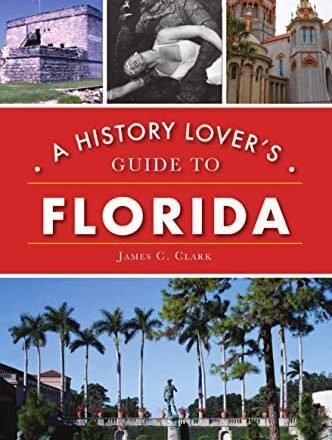The below is an excerpt from James C. Clark’s book A History Lover’s Guide to Florida. You can see James C. Clark at the Miami Book Fair on Saturday, November 19, at 12 p.m. in the MAGIC screening room at building 8.
It is a simple question that children learn in school: How many original colonies were there? I bet you said 13. Right?
The correct answer is 14. Number 14 is Florida, and we don’t talk about it because while the other 13 colonies fought for independence from Britain, Florida remained loyal to King George.
It was so loyal that three signers of the Declaration of Independence were imprisoned in the old Spanish fort in St. Augustine, and British troops used Florida as a base.
Florida’s history has always been different. As the historian Michael Gannon pointed out, by the time the Pilgrims and Jamestown settlers arrived, St. Augustine was already undergoing urban renewal.
Because so many Floridians come from somewhere else, few know the state’s rich history. Here are ten things you might not know!
- The first president to come to Florida was Chester A. Arthur in 1883, who could not go south of Kissimmee because there was no telegraph, and could not be out of touch.
- Florida helped three future presidents achieve a national reputation. Andrew Johnson and Zachary Taylor came to fight the Seminoles, and Teddy Roosevelt and his Rough Riders embarked for Cuba from Tampa.
- The first passenger airline began in Florida in 1914. Tony Janus flew passengers from St. Petersburg to Tampa in an era when no bridges connected the two. It lasted only a few months. Four airlines, Pan American, National, Air Florida, and Eastern, started in Florida.
- Carl Fisher built the Indianapolis Motor Speedway and invented the first automobile headlight. He used his fortune to develop Miami Beach.
- Fort Mose, the first free-Black settlement in the New World, was established near St. Augustine in 1738.
- Tallahassee became the capital of Florida in 1824 because it is halfway between Pensacola and St. Augustine.
- In 1896, Henry Flagler’s railroad reached Miami, although he predicted the town would never be more than a fishing village.
- Fort Taylor in Key West and Fort Jefferson in the Dry Tortugas were obsolete before they were finished and have never been used in battle.
- Walt Disney chose Orlando as the site for his new amusement park on November 22, 1963. Several hours after picking Orlando, he learned that John Kennedy was assassinated in Dallas.
- Donald Trump isn’t the only president to own a home in Florida. John Kennedy, the Bush family, and Richard Nixon had Florida homes.


